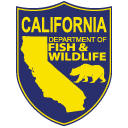
CDFW photo by C. Shen
The laid back, beachy vibe of the colorful coastal town of Santa Cruz conjures images of surfers gracefully riding the waves at Steamer Lane or locals leisurely navigating an oceanside bike trail on beach cruisers. Visitors flock to the world famous Santa Cruz Beach Boardwalk to experience the view of the Pacific Ocean and redwood-laden Santa Cruz Mountains from the top of that first epic hill on the Giant Dipper roller coaster. The historic wooden roller coaster has offered riders that iconic view for over a century, if they are brave enough to take the plunge. The ocean is baked into the town’s identity, from the world class marine science program at the University of California, Santa Cruz (UCSC), to the many cars cruising the town with surfboards strapped to their roofs.
Naturally, most of the people who call Santa Cruz home care deeply about the ocean, and the Santa Cruz Marine Protected Area (MPA) Collaborative is a grassroots organization that provides an outlet to turn that passion into action. Co-led by Lisa Uttal with the Monterey Bay National Marine Sanctuary and Nicole Crane, a professor at Cabrillo College, the Santa Cruz MPA Collaborative unites academic scientists, state and federal agencies, tribal members, ocean-centric non-profit organizations, and other local partners.

photo courtesy California State Parks
“As a co-chair of the Santa Cruz Collaborative for the past 5 years, [I can tell you that] our members are… the most diverse and rich in public and private organizations working together to protect one of the most diverse ecosystems in the ocean,” says Utall. “It is so heartwarming to have this forum to share our work with one another and to collaborate – it takes a village to get the job done.” Utall also notes that the mission of the Collaborative has become even more critical during the COVID-19 pandemic, as members help educate the many visitors flocking to the coast about MPAs and the impacts of trash on the marine environment.
The Santa Cruz MPAs often border state parks, so many of the projects created by the Collaborative help with outreach efforts by state park interpreters. At Natural Bridges State Beach and State Marine Reserve, beachgoers can get information about the MPA at a mobile cart that interpreters and docents can wheel across the sand. The cart includes general informational fliers about MPAs, a photo album of the inhabitants of the nearby tidepools, interactive games for kids, and even a real sea otter skull!
If you can’t get out to experience the MPA firsthand, take a virtual tour of the Santa Cruz MPA beaches on a mobile app called Mobile Ranger. The Collaborative helped create the tour which spans nearly 47 miles of coastline from Año Nuevo SMR in the north to Elkhorn Slough SMR and SMCA in the south. The interactive tours include stories about the local flora and fauna, the unique geology of the area, and the rich cultural connections between the coast and the local tribes.

CDFW photo by S. Worden
Although the Santa Cruz Collaborative helps educate visitors about the area’s natural beauty and history, it may be the more hidden aspects of the area that Collaborative members truly want to shed light on. Microscopic plants and animals known as plankton casually drift with the ocean’s currents, and are usually abundant in coastal waters. Despite their tiny size, plankton can tell us big things about the condition of the ocean. Co-chairs Nicole Crane and Lisa Uttal coordinate a citizen science project through the Pacific Plankton Program at Cabrillo College and Dr. Raphael Kudela’s lab at UCSC that trains students and community volunteers to regularly collect and identify plankton at seven monitoring sites in the Monterey Bay National Marine Sanctuary and some state MPAs. Collecting information on the types of plankton present in coastal waters can help scientists and the California Department of Public Health predict changes in ocean conditions that can cause events like harmful algal blooms. Check out the CA HABMAP forecasting website for information on current conditions.
 The Santa Cruz Collaborative is one of 14 Collaboratives that are loosely associated with California’s coastal counties and make up the MPA Collaborative Network. Anyone is welcome to join an MPA Collaborative, attend meetings, and help with projects. MPA Collaboratives are always looking to expand their membership and increase stakeholder representation. If you’d like to get involved in your local Collaborative, visit the MPA Collaborative webpage and sign up for the mailing list to receive information on upcoming meetings and locally-relevant updates.
The Santa Cruz Collaborative is one of 14 Collaboratives that are loosely associated with California’s coastal counties and make up the MPA Collaborative Network. Anyone is welcome to join an MPA Collaborative, attend meetings, and help with projects. MPA Collaboratives are always looking to expand their membership and increase stakeholder representation. If you’d like to get involved in your local Collaborative, visit the MPA Collaborative webpage and sign up for the mailing list to receive information on upcoming meetings and locally-relevant updates.
post by Sara Worden, CDFW Environmental Scientist
This article is part of a series featuring California MPA  Collaboratives. Read archived MPA News articles and the series Exploring California’s MPAs for more stories and information about California’s marine protected areas!
Collaboratives. Read archived MPA News articles and the series Exploring California’s MPAs for more stories and information about California’s marine protected areas!

